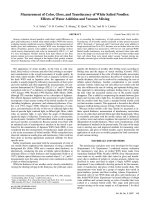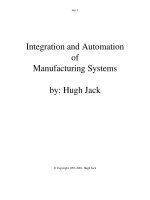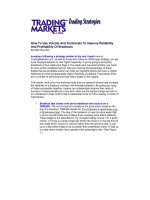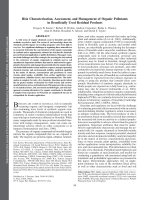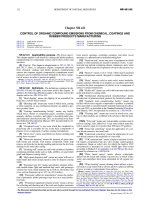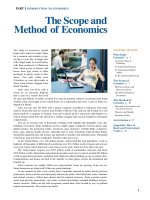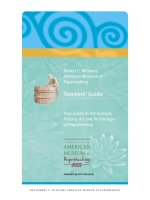Density and Viscosity of Water_2 pdf
Bạn đang xem bản rút gọn của tài liệu. Xem và tải ngay bản đầy đủ của tài liệu tại đây (801.9 KB, 22 trang )
PHYSICAL–CHEMICAL
TREATMENT OF WATER
AND WASTEWATER
CRC PRESS
Boca Raton London New York Washington, D.C.
PHYSICAL–CHEMICAL
TREATMENT OF WATER
AND WASTEWATER
Arcadio P. Sincero Sr., D.Sc., P.E.
Morgan State University
Baltimore, Maryland
Gregoria A. Sincero, M. Eng., P.E.
Department of the Environment
State of Maryland
This book contains information obtained from authentic and highly regarded sources. Reprinted material
is quoted with permission, and sources are indicated. A wide variety of references are listed. Reasonable
efforts have been made to publish reliable data and information, but the author and the publisher cannot
assume responsibility for the validity of all materials or for the consequences of their use.
Neither this book nor any part may be reproduced or transmitted in any form or by any means, electronic
or mechanical, including photocopying, microfilming, and recording, or by any information storage or
retrieval system, without prior permission in writing from the publisher.
The consent of CRC Press LLC does not extend to copying for general distribution, for promotion, for
creating new works, or for resale. Specific permission must be obtained in writing from CRC Press LLC
for such copying.
Direct all inquiries to CRC Press LLC, 2000 N.W. Corporate Blvd., Boca Raton, Florida 33431.
Trademark Notice:
Product or corporate names may be trademarks or registered trademarks, and are
used only for identification and explanation, without intent to infringe.
Visit the CRC Press Web site at www.crcpress.com
© 2003 by A. P. Sincero and G. A. Sincero
Co-published by IWA Publishing, Alliance House, 12 Caxton Street, London, SW1H 0QS, UK
Tel. +44 (0) 20 7654 5500, Fax +44 (0) 20 7654 5555
www.iwapublishing.com
ISBN 1-84339-028-0
No claim to original U.S. Government works
International Standard Book Number 1-58716-124-9
Library of Congress Card Number 2002023757
Printed in the United States of America 1 2 3 4 5 6 7 8 9 0
Printed on acid-free paper
Library of Congress Cataloging-in-Publication Data
Sincero, Arcadio P. (Arcadio Pacquiao)
Physical–chemical treatment of water and wastewater / Arcadio Pacquiao Sincero, Sr.,
Gregoria Alivio Sincero.
p. cm.
Includes bibliographical references and index.
ISBN 1-58716-124-9 (alk. paper)
1. Water—Purification. 2. Sewage—Purification. I. Sincero, Gregoria A. (Gregoria Alivio)
II. Title
TD430 .S47 2002
628.1
′
62—dc21 2002023757
TX249_Frame_CFM.fm Page 4 Wednesday, June 19, 2002 1:28 PM
Preface
This textbook is intended for undergraduate students in their junior and senior years
in environmental, civil, and chemical engineering, and students in other disciplines
who are required to take the course in physical–chemical treatment of water and
wastewater. This book is also intended for graduate students in the aforementioned
disciplines as well as practicing professionals in the field of environmental engi-
neering. These professionals include plant personnel involved in the treatment of
water and wastewater, consulting engineers, public works engineers, environmental
engineers, civil engineers, chemical engineers, etc. They are normally employed in
consulting firms, city and county public works departments, and engineering depart-
ments of industries, and in various water and wastewater treatment plants in cities,
municipalities, and industries. These professionals are also likely to be employed in
government agencies such as the U.S. Environmental Protection Agency, and state
agencies such as the Maryland Department of the Environment.
The prerequisites for this textbook are general chemistry, mathematics up to
calculus, and fluid mechanics. In very few instances, an elementary knowledge of
calculus is used, but mostly the mathematical treatment makes intensive use of
algebra. The entire contents of this book could be conveniently covered in two
semesters at three credits per semester. For schools offering only one course in
physical–chemical treatment of water and wastewater, this book gives the instructor
the liberty of picking the particular topics required in a given curriculum design.
After the student has been introduced to the preliminary topics of water and
wastewater characterization, quantitation, and population projection, this book covers
the unit operations and unit processes in the physical–chemical treatment of water
and wastewater. The unit operations cover flow measurements and flow and quality
equalization; pumping; screening, sedimentation, and flotation; mixing and floccu-
lation; conventional filtration; advanced filtration and carbon adsorption; and aeration,
absorption, and stripping. The unit processes cover water softening, water stabiliza-
tion, coagulation, removal of iron and manganese, removal of phosphorus, removal
of nitrogen, ion exchange, and disinfection.
The requirements for the treatment of water and wastewater are driven by the
Safe Drinking Water Act and Clean Water Act, which add more stringent require-
ments from one amendment to the next. For example, the act relating to drinking
water quality, known as the Interstate Quarantine Act of 1893, started with only the
promulgation of a regulation prohibiting the use of the common cup. At present, the
Safe Drinking Water Act requires the setting of drinking water regulations for some
83 contaminants. The act relating to water quality started with the prohibition of
obstructions in harbors as embodied in the Rivers and Harbors Act of 1899. At
present, the Clean Water Act requires that discharges into receiving streams meet
water quality standards; in fact, regulations such as those in Maryland have an
TX249_Frame_CFM.fm Page 5 Friday, June 14, 2002 4:51 PM
© 2003 by A. P. Sincero and G. A. Sincero
antidegradation policy. In recent years, problems with
Cryptosporidium parvum
and
Giardia lamblia
have come to the fore. Toxic substances are being produced by
industries every day which could end up in the community water supply. These acts
are technology forcing, which means that as we continue to discover more of the
harmful effects of pollutants on public health and welfare and the environment,
advanced technology will continue to be developed to meet the needs of treatment.
The discipline of environmental engineering has mostly been based on empirical
knowledge, and environmental engineering textbooks until recently have been writ-
ten in a descriptive manner. In the past, the rule of thumb was all that was necessary.
Meeting the above and similar challenges, however, would require more than just
empirical knowledge and would require stepping up into the next level of sophisti-
cation in treatment technology. For this reason, this textbook is not only descriptive
but is also analytical in nature. It is hoped that sound concepts and principles will
be added to the already existing large body of empirical knowledge in the discipline.
These authors believe that achieving the next generation of treatment requirements
would require the next level of sophistication in technology. To this end, a textbook
written to address the issue would have to be analytical in nature, in addition to
adequately describing the various unit operations and processes.
This book teaches both principles and design. Principles are enunciated in the
simplest way possible. Equations presented are first derived, except those that are
obtained empirically. Statements such as “It can be shown…” are not used in this
book. These authors believe in imparting the principles and concepts of the subject
matter, which may not be done by using “it-can-be-shown” statements. At the end
of each chapter, where appropriate, are numerous problems that can be worked out
by the students and assigned as homework by the instructor.
The question of determining the correct design flows needs to be addressed. Any
unit can be designed once the flow has been determined, but how was the flow
determined in the first place? Methods of determining the various design flows are
discussed in this book. These methods include the determination of the average daily
flow rate, maximum daily flow rate, peak hourly flow rate, minimum daily flow rate,
minimum hourly flow rate, sustained high flow rate, and sustained low flow rate.
What is really meant when a certain unit is said to be designed for the average
flow or for the peak flow or for any flow? The answer to this question is not as easy
as it may seem. This book uses the concept of the probability distribution to derive
these flows. On the other hand, the loss through a filter bed may need to be
determined or a deep-well pump may need to be specified. The quantity of sludge
for disposal produced from a water softening process may also be calculated. This
book uses fluid mechanics and chemistry without restraint to answer these design
problems.
Equivalents and equivalent mass are two troublesome and confusing concepts.
If the chemistry and environmental engineering literature were reviewed, these
subjects would be found to be not well explained. Equivalents and equivalent mass
in a unified fashion are explained herein using the concept of the reference species.
Throughout the unit processes section of this book, reference species as a method
is applied. Related to equivalents and equivalent mass is the dilemma of expressing
concentrations in terms of calcium carbonate. Why, for example, is the concentration
TX249_Frame_CFM.fm Page 6 Friday, June 14, 2002 4:51 PM
© 2003 by A. P. Sincero and G. A. Sincero
of acidity expressed in terms of calcium carbonate when calcium carbonate is basic
and acidity is acidic? This apparent contradiction is addressed in this book.
As in any other textbook, some omissions and additions may have produced
some error in this book. The authors would be very grateful if the reader would
bring them to our attention.
TX249_Frame_CFM.fm Page 7 Friday, June 14, 2002 4:51 PM
© 2003 by A. P. Sincero and G. A. Sincero
Acknowledgments
First, I acknowledge Dr. Joseph L. Eckenrode, former Publisher, Environmental
Science & Technology, Technomic Publishing Company, Inc. Dr. Eckenrode was
very thorough in determining the quality, timeliness, and necessity of the manuscript.
It was only when he was completely satisfied through the strict peer review process
that he decided to negotiate for a contract to publish the book. Additionally, I
acknowledge Brian Kenet and Sara Seltzer Kreisman at CRC Press.
This book was written during my tenure at Morgan State University. I acknowl-
edge the administrators of this fine institution, in particular, Dr. Earl S. Richardson,
President; Dr. Clara I. Adams, Vice President for Academic Affairs; Dr. Eugene M
DeLoatch, Dean of the School of Engineering; and Dr. Reginald L. Amory, Chairman
of the Department of Civil Engineering. I make special mention of my colleague,
Dr. Robert Johnson, who was the acting Chairman of the Department of Civil
Engineering when I came on board. I also acknowledge my colleagues in the
department: Dr. Donald Helm, Prof. A. Bert Davy, Dr. Indranil Goswami, Dr. Jiang Li,
Dr. Iheanyi Eronini, Dr. Gbekeloluwa B. Oguntimein, Prof. Charles Oluokun, and
Prof. Neal Willoughby.
This acknowledgment would not be complete if I did not mention my advisor
in doctoral studies and three of my former professors at the Asian Institute of
Technology (A.I.T.) in Bangkok, Thailand. Dr. Bruce A. Bell was my advisor at the
George Washington University where I earned my doctorate in Environmental–Civil
Engineering. Dr. Roscoe F. Ward, Dr. Rolf T. Skrinde, and Prof. Mainwaring B. Pescod
were my former professors at A.I.T., where I earned my Masters in Environmental–
Civil Engineering.
I acknowledge and thank my wife, Gregoria, for contributing Chapter 2 (Con-
stituents of Water and Wastewater) and Chapter 7 (Conventional Filtration). I also
acknowledge my son, Roscoe, for contributing Chapter 17 (Disinfection). Gregoria
also contributed a chapter on solid waste management when I wrote my first book
Environmental Engineering: A Design Approach
. This book was published by Pren-
tice Hall and is being adopted as a textbook by several universities here and abroad.
This book has been recommended as a material for review in obtaining the Diplomate
in Environmental Engineering from the Academy of Environmental Engineers.
Lastly, I dedicate this book to members of my family: Gregoria, my wife; Roscoe
and Arcadio Jr., my sons; the late Gaudiosa Pacquiao Sincero, my mother; Santiago
Encarguiz Sincero, my father; and the late Aguido and the late Teodora Managase
Alivio, my father-in-law and my mother-in-law, respectively. I also dedicate this
book to my brother Meliton and to his wife Nena; to my sister Anelda and to her
husband Isidro; to my other sister Feliza and to her husband Martin; and to my
brother-in-law Col. Miguel M. Alivio, MD and to his wife Isabel. My thoughts also
go to my other brothers-in-law: the late Tolentino and his late wife Mary, Maximino
TX249_Frame_CFM.fm Page 9 Friday, June 14, 2002 4:51 PM
© 2003 by A. P. Sincero and G. A. Sincero
and his wife Juanita, Restituto and his wife Ignacia, the late Anselmo and his wife
Silvina, and to my sisters-in-law: the late Basilides and her late husband Dr. Alfonso
Madarang, Clarita and her late husband Elpidio Zamora, Luz and her husband
Perpetuo Apale, and Estelita.
Arcadio P. Sincero
Morgan State University
TX249_Frame_CFM.fm Page 10 Friday, June 14, 2002 4:51 PM
© 2003 by A. P. Sincero and G. A. Sincero
About the Authors
Arcadio P. Sincero
is Associate Professor of Civil Engineering at Morgan State
University, Baltimore, MD. He was also a former professor at the Cebu Institute of
Technology, Philippines. He holds a Bachelor’s degree in Chemical Engineering
from the Cebu Institute of Technology, a Master’s degree in Environmental–Civil
Engineering from the Asian Institute of Technology, Bangkok, and a Doctor of
Science degree in Environmental–Civil Engineering from the George Washington
University. He is a registered Professional Engineer in the Commonwealth of Penn-
sylvania and in the State of Maryland and was a registered Professional Chemical
Engineer in the Philippines. He is a member of the American Society of Civil Engi-
neers, a member of the American Institute of Chemical Engineers, a member of the
Water Environment Federation, a member of the American Association of University
Professors, and a member of the American Society of Engineering Education.
Dr. Sincero has a wide variety of practical experiences. He was a shift supervisor
in a copper ore processing plant and a production foreman in a corn starch processing
plant in the Philippines. He was CPM (Critical Path Method) Planner in a construc-
tion management firm and Public Works Engineer in the City of Baltimore. In the
State of Maryland, he was Public Health Engineer in the Bureau of Air Quality and
Noise Control, Department of Health and Mental Hygiene; Water Resources Engi-
neer in the Water Resources Administration, Department of Natural Resources; Water
Resources Engineer in the Office of Environmental Programs, Department of Health
and Mental Hygiene; Water Resources Engineer in the Water Management Admin-
istration, Maryland Department of the Environment. For his positions with the State
of Maryland, Dr. Sincero had been Chief of his divisions starting in 1978. His last
position in the State was Chief of Permits Division of the Construction Grants and
Permits Program, Water Management Administration, Maryland Department of the
Environment. These practical experiences have allowed Dr. Sincero to gain a wide
range of environmental engineering and regulatory experiences: air, water, solid
waste, and environmental quality modeling.
Gregoria A. Sincero
is a senior level Water Resources Engineer at the Maryland
Department of the Environment. She was also a former professor at the Cebu Institute
of Technology, Philippines. She holds a Bachelor’s degree in Chemical Engineering
from the Cebu Institute of Technology and a Master’s degree in Environmental–Civil
Engineering from the Asian Institute of Technology, Bangkok, Thailand. She is a
registered Professional Environmental Engineer in the Commonwealth of Pennsyl-
vania and was a registered Professional Chemical Engineer in the Philippines. She
is a member of the American Institute of Chemical Engineers.
Mrs. Sincero has practical experiences both in engineering and in governmental
regulations. She was Senior Chemist/Microbiologist in the Ashburton Filters of
TX249_Frame_CFM.fm Page 11 Friday, June 14, 2002 4:51 PM
© 2003 by A. P. Sincero and G. A. Sincero
Baltimore City. In the State of Maryland, she was Water Resource Engineer in the
Water Resources Administration, Department of Natural Resources and Water
Resources Engineer in the Office of Environmental Programs, Department of Health
and Mental Hygiene, before joining her present position in 1988 at MDE. At MDE,
she is a senior project manager reviewing engineering plans and specifications and
inspecting construction of refuse disposal facilities such as landfills, incinerators,
transfer stations, and processing facilities. Also, she has experiences in modeling of
surface waters, groundwaters, and air and statistical evaluation of groundwater and
drinking water data using EPA’s Gritstat software.
TX249_Frame_CFM.fm Page 12 Friday, June 14, 2002 4:51 PM
© 2003 by A. P. Sincero and G. A. Sincero
Contents
Background Prerequisites
Introduction
Wastewater
Physical–Chemical Treatment of Water and Wastewater
Unit Operations and Unit Processes
Coverage
Clean Water Act
Regulatory Requirements
Federal Financial Assistance
Permits and Enforcement
Federal and State Relationships
Safe Drinking Water Act
Highlights of the Safe Drinking Water Act
Development of MCLs and MCLGs
Drinking Water Regulations under the Act
Federal Financial Assistance
Federal and State Relationships
Relationship of This Book to the Acts
Glossary
Background Chemistry and Fluid Mechanics
Units Used in Calculation
General Chemistry
Equivalents and Equivalent Masses
Methods of Expressing Concentrations
Activity and Active Concentration
Equilibrium and Solubility Product Constants
Acids and Bases
Fluid Mechanics
Integration Symbols
Vectors
Gauss–Green Divergence Theorem
Partial versus Total Derivative
Reynolds Transport Theorem
Glossary
Problems
Bibliography
TX249_Frame_CFM.fm Page 13 Friday, June 14, 2002 4:51 PM
© 2003 by A. P. Sincero and G. A. Sincero
PART I
Characteristics of Water and Wastewater
Chapter 1
Quantity of Water and Wastewater
1.1 Probability Distribution Analysis
1.1.1 Addition and Multiplication Rules
of Probability
1.1.2 Values Equaled or Exceeded
1.1.3 Derivation of Probability from
Recorded Observation
1.1.4 Values Equaled or Not Exceeded
1.2 Quantity of Water
1.2.1 Design Period
1.3 Types of Wastewater
1.4 Sources and Quantities of Wastewater
1.4.1 Residential
1.4.2 Commercial
1.4.3 Institutional
1.4.4 Recreational
1.4.5 Industrial
1.5 Population Projection
1.5.1 Arithmetic Method
1.5.2 Geometric Method
1.5.3 Declining-Rate-of-Increase Method
1.5.4 Logistic Method
1.5.5 Graphical Comparison Method
1.6 Derivation of Design Flows of Wastewaters
1.6.1 Design Flows
1.7 Deriving Design Flows of Wastewaters from Field Survey
1.7.1 Average Daily Flow Rate
1.7.2 Peak Hourly Flow Rate
1.7.3 Maximum Daily Flow Rate
1.7.4 Minimum Hourly Flow Rate and Minimum
Daily Flow Rate
1.7.5 Sustained Peak Flow Rate and Sustained Minimum
Flow Rate
1.7.6 Infiltration–Inflow
1.7.7 Summary Comments for Deriving Flow Rates
by the Probability Distribution Analysis
Glossary
Symbols
Problems
Bibliography
TX249_Frame_CFM.fm Page 14 Thursday, June 20, 2002 3:45 PM
© 2003 by A. P. Sincero and G. A. Sincero
Chapter 2
Constituents of Water and Wastewater
2.1 Physical and Chemical Characteristics
2.1.1 Turbidity
2.1.2 Color
2.1.3 Taste
2.1.4 Odor
2.1.5 Temperature
2.1.6 Chlorides
2.1.7 Fluorides
2.1.8 Iron and Manganese
2.1.9 Lead and Copper
2.1.10 Nitrate
2.1.11 Sodium
2.1.12 Sulfate
2.1.13 Zinc
2.1.14 Biochemical Oxygen Demand
2.1.15 Nitrification in the BOD Test
2.1.16 Mathematical Analysis of BOD Laboratory Data
2.1.17 Solids
2.1.18 pH
2.1.19 Chemical Oxygen Demand
2.1.20 Total Organic Carbon
2.1.21 Nitrogen
2.1.22 Phosphorus
2.1.23 Acidity and Alkalinity
2.1.24 Fats, Oils, Waxes, and Grease
2.1.25 Surfactants
2.1.26 Priority Pollutants
2.1.27 Volatile Organic Compounds
2.1.28 Toxic Metal and Nonmetal Ions
2.2 Normal Constituents of Domestic Wastewater
2.3 Microbiological Characteristics
2.3.1 Bacteria
2.3.2 Test for the Coliform Group
2.3.3 The Poisson Distribution
2.3.4 Estimation of Coliform Densities
by the MPN Method
2.3.5 Interpolation or Extrapolation of the MPN Table
2.3.6 Viruses
2.3.7 Protozoa
Glossary
Symbols
Problems
Bibliography
TX249_Frame_CFM.fm Page 15 Friday, June 14, 2002 4:51 PM
© 2003 by A. P. Sincero and G. A. Sincero
PART II
Unit Operations of Water
and Wastewater Treatment
Chapter 3
Flow Measurements and Flow and Quality Equalizations
3.1 Flow Meters
3.1.1 Rectangular Weirs
3.1.2 Triangular Weirs
3.1.3 Trapezoidal Weirs
3.1.4 Venturi Meters
3.1.5 Parshall Flumes
3.2 Miscellaneous Flow Meters
3.3 Liquid Level Indicators
3.4 Flow and Quality Equalizations
Glossary
Symbols
Problems
Bibliography
Chapter 4
Pumping
4.1 Pumping Stations and Types of Pumps
4.2 Pumping Station Heads
4.2.1 Total Developed Head
4.2.2 Inlet and Outlet Manometric Heads; Inlet
and Outlet Dynamic Heads
4.3 Pump Characteristics and Best Operating Efficiency
4.4 Pump Scaling Laws
4.5 Pump Specific Speed
4.6 Net Positive Suction Head and Deep-Well Pumps
4.7 Pumping Station Head Analysis
Glossary
Symbols
Problems
Bibliography
Chapter 5
Screening, Settling, and Flotation
5.1 Screening
5.1.1 Head Losses in Screens and Bar Racks
5.1.2 Head Loss in Microstrainers
5.2 Settling
5.2.1 Flow-Through Velocity and Overflow Rate
of Settling Basins
TX249_Frame_CFM.fm Page 16 Friday, June 14, 2002 4:51 PM
© 2003 by A. P. Sincero and G. A. Sincero
5.2.2 Discrete Settling
5.2.3 Outlet Control of Grit Channels
5.2.4 Flocculent Settling
5.2.5 Primary Settling and Water-Treatment
Sedimentation Basins
5.2.6 Zone Settling
5.2.7 Secondary Clarification and Thickening
5.3 Flotation
5.3.1 Laboratory Determination of Design Parameters
Glossary
Symbols
Problems
Bibliography
Chapter 6
Mixing and Flocculation
6.1 Rotational Mixers
6.1.1 Types of Impellers
6.1.2 Prevention of Swirling Flow
6.1.3 Power Dissipation in Rotational Mixers
6.2 Criteria for Effective Mixing
6.3 Pneumatic Mixers
6.3.1 Prediction of Number of Bubbles and Rise Velocity
6.3.2 Power Dissipation in Pneumatic Mixers
6.4 Hydraulic Mixers
6.4.1 Power Dissipation in Hydraulic Mixers
6.4.2 Mixing Power for Hydraulic Jumps
6.4.3 Volume and Detention Times of Hydraulic-Jump Mixers
6.4.4 Mixing Power for Weir Mixers
6.5 Flocculators
Glossary
Symbols
Problems
Bibliography
Chapter 7
Conventional Filtration
7.1 Types of Filters
7.2 Medium Specification for Granular Filters
7.3 Linear Momentum Equation Applied to Filters
7.4 Head Losses in Grain Filters
7.4.1 Clean-Filter Head Loss
7.4.2 Head Losses Due to Deposited Materials
7.5 Backwashing Head Loss in Granular Filters
7.6 Cake Filtration
7.6.1 Determination of
α
TX249_Frame_CFM.fm Page 17 Friday, June 14, 2002 4:51 PM
© 2003 by A. P. Sincero and G. A. Sincero
7.6.2 Design Cake Filtration Equation
7.6.3 Determination of Cake Filtration Parameters
Glossary
Symbols
Problems
Bibliography
Chapter 8
Advanced Filtration and Carbon Adsorption
8.1 Electrodialysis Membranes
8.1.1 Power Requirement of Electrodialysis Units
8.2 Pressure Membranes
8.2.1 Membrane Module Designs
8.2.2 Factors Affecting Solute Rejection and Breakthrough
8.2.3 Solute-Water Separation Theory
8.2.4 Types of Membranes
8.2.5 Membrane Performance Characterization
8.3 Carbon Adsorption
8.3.1 Activation Techniques
8.3.2 Adsorption Capacity
8.3.3 Determination of the Freundlich Constants
8.3.4 Determination of the Langmuir Constants
8.3.5 Bed Adsorption and Active Zone
8.3.6 Relative Velocities in Bed Adsorption
8.3.7 Head Losses in Bed Adsorption
Glossary
Symbols
Problems
Bibliography
Chapter 9
Aeration, Absorption, and Stripping
9.1 Mass Transfer Units
9.2 Interface for Mass Transfer, and Gas and Liquid Boundary Layers
9.3 Mathematics of Mass Transfer
9.4 Dimensions of the Overall Mass Transfer Coefficients
9.5 Mechanics of Aeration
9.5.1 Equipment Specification
9.5.2 Determination of Aeration Parameters
9.5.3 Calculation of Actual Oxygen Requirement, the AOR
9.5.4 Time of Contact
9.5.5 Sizing of Aeration Basins and Relationship to Contact Time
9.5.6 Contact for Bubble Aerators
9.6 Absorption and Stripping
9.6.1 Sizing of Absorption and Stripping Towers
9.6.2 Operating Line
TX249_Frame_CFM.fm Page 18 Friday, June 14, 2002 4:51 PM
© 2003 by A. P. Sincero and G. A. Sincero
9.6.3 Tower Height
9.6.4 Ammonia Stripping (or Absorption)
Glossary
Symbols
Problems
Bibliography
PART III
Unit Processes of Water
and Wastewater Treatment
Chapter 10
Water Softening
10.1 Hard Waters
10.2 Types of Hardness
10.3 Plant Types for Hardness Removal
10.4 The Equivalent CaCO
3
Concentration
10.5 Softening of Calcium Hardness
10.6 Softening of Magnesium Hardness
10.7 Lime–Soda Process
10.7.1 Calculation of Stoichiometric Lime Required
in the Lime–Soda Process
10.7.2 Key to Understanding Subscripts
10.7.3 Calculation of Stoichiometric Soda Ash Required
10.7.4 Calculation of Solids Produced
10.8 Order of Removal
10.9 Role of CO
2
in Removal
10.10 Excess Lime Treatment and Optimum Operational pH
10.11 Summary of Chemical Requirements
and Solids Produced
10.12 Sludge Volume Production
10.13 Chemical Species in the Treated Water
10.13.1 Limits of Technology
10.13.2 Concentration of Ca
2
+
10.13.3 Concentration of Mg
2
+
10.13.4 Concentration of
10.13.5 Concentration of
10.13.6 Concentration of Na
+
10.14 Relationships of the Fractional Removals
10.15 Notes on Equivalent Masses
10.16 Typical Design Parameters and Criteria
10.17 Split Treatment
10.18 Use of Alkalinity in Water Softening Calculations
Glossary
HCO
3
−
CO
3
2 −
TX249_Frame_CFM.fm Page 19 Friday, June 14, 2002 4:51 PM
© 2003 by A. P. Sincero and G. A. Sincero
Symbols
Problems
Bibliography
Chapter 11
Water Stabilization
11.1 Carbonate Equilibria
11.1.1 Ionic Strength
11.1.2 Equilibrium Constant as a Function of Temperature
11.1.3 ’s for Pertinent Chemical Reactions
of the Carbonate Equilibria
11.2 Criteria for Water Stability at Normal Conditions
11.2.1 Saturation pH and the Langelier Index
11.2.2 Determination of {Ca
2+
}
11.2.3 Total Alkalinity as Calcium Carbonate
11.2.4 Precipitation Potential
11.2.5 Determination of Percent Blocking Potential of Pipes
11.3 Recarbonation of Softened Water
Glossary
Symbols
Problems
Bibliography
Chapter 12
Coagulation
12.1 Colloid Behavior
12.2 Zeta Potential
12.3 Colloid Destabilization
12.4 Coagulation Process
12.4.1 Coagulants for the Coagulation Process
12.4.2 Coagulant Aids
12.4.3 Rapid Mix for Complete Coagulation
12.4.4 The Jar Test
12.5 Chemical Reactions of Alum
12.5.1 Determination of the Optimum pH
12.6 Chemical Reactions of the Ferrous Ion
12.6.1 Determination of the Optimum pH
12.7 Chemical Reactions of the Ferric Ion
12.7.1 Determination of the Optimum pH
12.8 Jar Tests for Optimum pH Determination
12.9 Chemical Requirements
12.9.1 Chemical Requirements in Alum Coagulation Treatment
12.9.2 Key to Understanding Subscripts
12.9.3 Chemical Requirements in Ferrous Coagulation Treatment
12.9.4 Chemical Requirements in Ferric Coagulation Treatment
12.10 Chemical Requirements for pH Adjustments
∆H
298
o
TX249_Frame_CFM.fm Page 20 Friday, June 14, 2002 4:51 PM
© 2003 by A. P. Sincero and G. A. Sincero
12.11 Alkalinity and Acidity Expressed as CaCO
3
12.12 Sludge Production
Glossary
Symbols
Problems
Bibliography
Chapter 13
Removal of Iron and Manganese by Chemical Precipitation
13.1 Natural Occurrences of Iron and Manganese
13.2 Modes of Removal of Iron and Manganese
13.3 Chemical Reactions of the Ferrous and the Ferric Ions
13.3.1 Practical Optimum pH Range for the Removal
of Ferrous and Ferric
13.4 Chemical Reactions of the Manganous Ion [Mn(II)]
13.4.1 Determination of the Optimum pH
13.4.2 Practical Optimum pH Range
for the Removal of Manganese
13.5 Oxidation of Iron and Manganese
to Reduce Precipitation pH
13.6 Unit Operations for Iron and Manganese Removal
13.6.1 High pH Range
13.6.2 Low pH Range
13.7 Chemical Requirements
13.7.1 Requirements in the Ferrous Reactions
13.7.2 Requirements in the Manganous Reactions
13.8 Alkalinity Expressed in OH
−
and Acidity Expressed in H
+
13.9 Chemical Requirements for pH Adjustments
13.10 Sludge Production
Glossary
Symbols
Problems
Bibliography
Chapter 14
Removal of Phosphorus by Chemical Precipitation
14.1 Natural Occurrence of Phosphorus
14.2 Modes of Phosphorus Removal
14.3 Chemical Reaction of the Phosphate Ion with Alum
14.3.1 Determination of the Optimum pH Range
14.4 Chemical Reaction of the Phosphate Ion with Lime
14.4.1 Determination of the Optimum pH
and the Optimum pH Range
14.5 Chemical Reaction of the Phosphate Ion with the Ferric Salts
14.5.1 Determination of the Optimum pH
and the Optimum pH Range
TX249_Frame_CFM.fm Page 21 Friday, June 14, 2002 4:51 PM
© 2003 by A. P. Sincero and G. A. Sincero
14.6 Comments on the Optimum pH Ranges
14.7 Effect of the
K
sp
’s on the Precipitation of Phosphorus
14.8 Unit Operations for Phosphorus Removal
14.9 Chemical Requirements
14.10 Sludge Production
Glossary
Symbols
Problems
Bibliography
Chapter 15
Removal of Nitrogen by Nitrification–Denitrification
15.1 Natural Occurrence of Nitrogen
15.2 To Remove or Not to Remove Nitrogen
15.3 Microbial Thermodynamics
15.3.1 Enthalpy and Entropy
15.3.2 Free Energy
15.4 Oxidation-Reduction Reactions of Nitrogen Foods
15.4.1 Criterion for Spontaneous Process
15.5 Modes of Nitrogen Removal
15.6 Chemical Reactions in Nitrogen Removal
15.6.1 Nitrification:
Nitrosomonas
Stage
15.6.2 Nitrification:
Nitrobacter
Stage
15.6.3 Overall Nitrification
15.6.4 Denitrification: Heterotrophic Side Reaction Stage
15.6.5 Denitrification: Normal Anoxic Stage
15.6.6 Denitrification: NO
2
-Reduction Side
Reaction Stage
15.7 Total Effluent Nitrogen
15.7.1 Units of Cell Yields
15.8 Carbon Requirements for Denitrification
15.9 Alkalinity Production and Associated Carbon Requirement
15.10 Reaction Kinetics
15.10.1 Kinetics of Growth and Food Utilization
15.10.2 Material Balance around the Activated Sludge Process
15.10.3 Nitrification Kinetics
15.10.4 Denitrification Kinetics
15.10.5 Carbon Kinetics
15.10.6 Reactor Sizing
15.10.7 Determination of Kinetic Constants
Glossary
Symbols
Problems
Bibliography
TX249_Frame_CFM.fm Page 22 Friday, June 14, 2002 4:51 PM
© 2003 by A. P. Sincero and G. A. Sincero
Chapter 16
Ion Exchange
16.1 Ion Exchange Reactions
16.2 Unit Operations of Ion Exchange
16.3 Sodium, Hydrogen Cycle, and Regeneration
16.4 Production of “Pure Water”
16.5 Active or Exchange Zone
16.6 Design of Ion Exchangers
16.6.1 Quantity of Exchange Materials
16.6.2 Quantity of Regenerant
16.6.3 Wastewater Production
16.7 Head Losses in Ion Exchangers
Glossary
Symbols
Problems
Bibliography
Chapter 17
Disinfection
17.1 Methods of Disinfection and Disinfectant Agents Used
17.2 Factors Affecting Disinfection
17.2.1 Time of Contact and Intensity of Disinfectant
17.2.2 Age of the Microorganism
17.2.3 Nature of the Suspending Fluid
17.2.4 Effect of Temperature
17.3 Other Disinfection Formulas
17.4 Chlorine Disinfectants
17.4.1 Chlorine Chemistry
17.4.2 Design of Chlorination Unit Operations Facilities
17.5 Dechlorination
17.5.1 Chemical Reactions Using Sulfur
Dechlorinating Agents
17.5.2 Chemical Reactions Using Activated Carbon
17.5.3 Effect of Dechlorinated Effluents on Dissolved Oxygen
of Receiving Streams
17.5.4 Unit Operations in Dechlorination
17.6 Disinfection Using Ozone
17.6.1 Unit Operations in Ozonation
17.7 Disinfection Using Ultraviolet Light
17.7.1 Unit Operations in UV Disinfection
Glossary
Symbols
Problems
Bibliography
TX249_Frame_CFM.fm Page 23 Friday, June 14, 2002 4:51 PM
© 2003 by A. P. Sincero and G. A. Sincero
Appendices and Index
Appendix 1
Density and Viscosity of Water
Appendix 2
Atomic Masses of the Elements Based on C-12
Appendix 3
Saturation Values of Dissolved Oxygen Exposed to Saturated
Atmosphere at One Atmosphere Pressure
at Given Temperatures
Appendix 4
SDWA Acronyms
Appendix 5
Sample Drinking Water VOCs
Appendix 6
Sample Drinking Water SOCs and IOCs
Appendix 7
Secondary MCLs for a Number of Substances
Appendix 8
Some Primary Drinking-Water Criteria
Appendix 9
Some Secondary Drinking-Water Criteria
Appendix 10
Physical Constants
Appendix 11
Conversion Factors
TX249_Frame_CFM.fm Page 24 Friday, June 14, 2002 4:51 PM
© 2003 by A. P. Sincero and G. A. Sincero
